SOUTH DAKOTA SOYBE A N LEADER
Many Factors Have an Impact on Soybean Yields

5 Soybean Uses You May Have Never Heard Of
Full Circle: SD Soybean Farmers
See Long-Term Investments Pay Off Research Reports
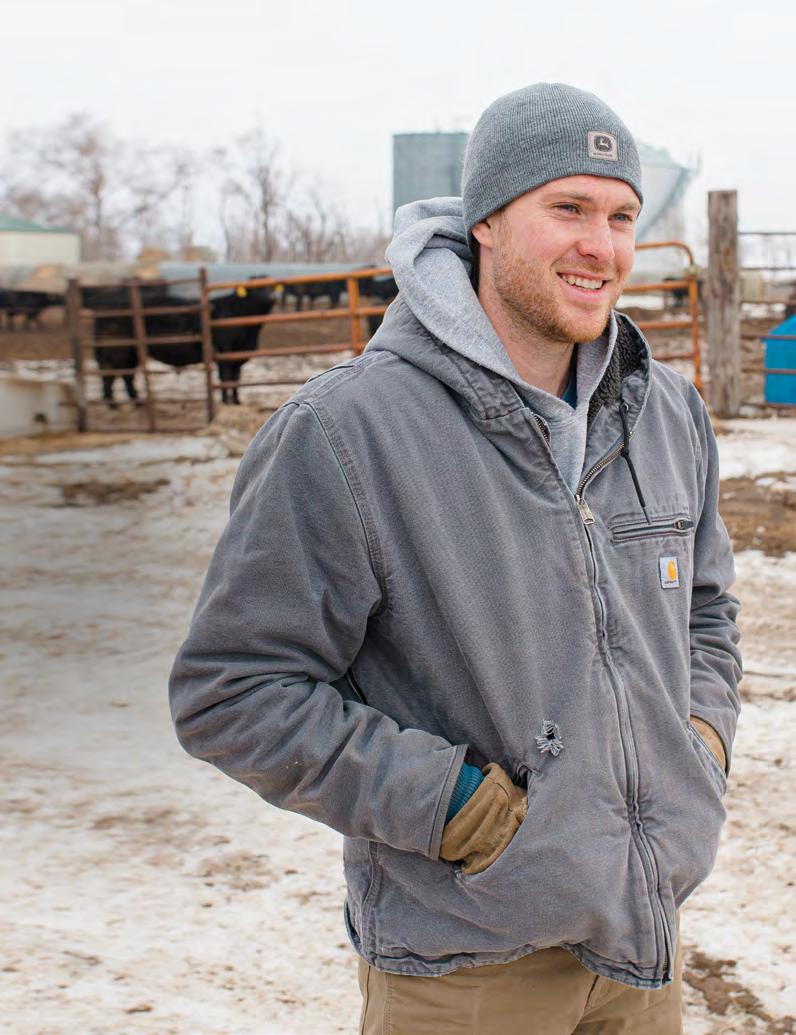

2024 Spring Check-In
Soy Industry News
publication of the South Dakota Soybean Association Spring Issue 2024
A
Read
Fourth Generation farmer, Cole Sonne, shares farming with YouTube audience
full story on page 16.
BELIEVE YOU CAN.
FOR

II
WE LIVE BY FAITH, NOT BY SIGHT.
5 : 7
CORINTHIANS
President
Kevin Deinert, Mount Vernon
First Vice President
Chad Schooley, Castlewood
Second Vice President
Drew Peterson, Salem
Secretary
Tanner Hento, Avon
Treasurer
Brent Greenway, Mitchell
Directors
Chad Nelsen, Viborg
Derrick Scott, Geddes
Dan Nigg, Sisseton
Jesse King, Toronto
Jeff Thompson, Colton
Andy Weisser, Roscoe
ASA Corteva Young Leaders
2022-23 Jeff Kloucek, Tabor 2023-24 Ross Tschetter, Bridgewater 2023-24 Riley Schoenfelder, Parkston
Industry Representatives
Kari Vander Wal, South Dakota
Soybean Processors
Joe Schefers, Bayer Crop Science
Terry Schultz, Mustang Seeds
Travis Bunde, Raven Industries
Jeff Behrens, Pioneer
American Soybean Association
Brandon Wipf, Huron
Jordan Scott, Valley Springs
Paul Casper, Lake Preston
Editor/Design Director
Mariah Kessler, SD Soybean Communications Director
South Dakota Soybean Leader is published four times a year by the South Dakota Soybean Association, 5000 S. Broadband Lane, Suite 100, Sioux Falls, SD 57108 Phone: 605-330-9942. For address corrections contact South Dakota Soybean Leader at 5000 S. Broadband Lane, Suite 100, Sioux Falls, SD 57108.
www.sdsoybean.org | sdsa@sdsoybean.org
Comments and
be
to the above address.
PRESIDENT’S OUTLOOK
By Kevin Deinert, President of the South Dakota Soybean Association
Welcome to the off season! Or so we always think it will be. As the marathon of harvest wraps up and we settle into the more “relaxed” time of winter, it never fails that spring sneaks up and reminds us that planting is just around the corner again. Short days and cold nights whisk past us on the calendar and make the winter months seem like a blur (or maybe that was just all the fog?). And whether you are a staunch follower of wives’ tales or have a favorite weather person, Mother Nature will be sure to keep us on our toes as we navigate the excitement and anticipation of another crop year.

While our volunteer farmer leaders here at SD Soybean may enjoy some downtime from the farm activities this winter, their time and attention shift to meetings, events, and duties that are asked of them as a director. It is no secret that soybean prices are not the most flattering currently. Thus, our directors continue to be engaged throughout the industry to develop new markets, maintain relationships, and foster growth. That growth comes from not only raw products but also the many by-products’ soybeans have generated. Exciting innovations have seen soybeans used in places that could not always be imagined.
Some of our directors work and collaborate actively abroad, and all of us continue to work here in South Dakota at our various events. From Soy100 to our Shop Talks, be on the lookout for events hosted by SD Soybean. These events help us disseminate information and gather feedback from you, the producer.
Farming is the greatest challenge that reaps some of the greatest rewards. As we look towards this coming growing season, challenges are plentiful. Commodity prices, weather, and input economics will continue to throw curve balls at us this spring. And while the farming landscape has changed through the years, the resilience of the South Dakota farmer continues through the generations. I pray that through the stress of crunching numbers, tilling the fields, and sowing the seed we reflect on how truly blessed we are to carry on one the noblest of professions.
God bless and stay safe this spring!
Sincerely,
Kevin Deinert

Spring Issue 2024 SDSL 3
claims
against the
of
publication of the content of the
Advertising Inquiries
Gross, AGE Media
garrett@agemedia.pub
statewide news articles should
sent
Advertising space reservations must be made by the first of the month preceding publication. In consideration of the acceptance of advertisement, the agency and the advertiser must, in respect of the contents of the advertisement, indemnify and save the publisher harmless against any expense arising from
or actions
publisher because
the
advertisement.
Garrett
(605) 251-6370 |
www.agemedia.pub
Paying checkoff does not automatically make you a member of SDSA. SDSA has membership dues.
KEVIN DEINERT SDSA President
SDSL
3
5
6
9
10
12
14
16
17
20 Full Circle: South Dakota Soybean Farmers
23 Research
31 South Dakota Soybean Stories: Tanner Hento
32 Soy Transportation Coalition Contribution
34 2023 AgOutlook

4 Spring Issue 2024 SDSL
President’s Outlook
Letter From the Chairman
Soy Industry News
Letter from the Executive Director
Many Factors Have an Impact on Soybean Yields
5 Soybean Uses You May Have Never Heard Of
Soy Meets World: How Checkoff Initiatives Prepare Our Soybean Industry for the Future
Hungry for Truth: Fourth Generation Farmer Shares Farming with YouTube Audience
Cheese Egg Bakes
Hungry for Truth Recipe: Mini Ham and
See
Investments Pay Off
Long-Term
Reports
Furthers
Great Lakes Port
A public a tion of t he S ou t h Dakota S oybean As so ci at io n SO U T H D A K OT A S OY B E A N L E A D E R
Awards
Spring Issue 2024 Volume 13 Number 1 1-605-271-0897 Download this FREE guide book to find out what pre-engineered building is right for you Pre-engineered metal buildings are durable, customizable, versatile, and built to withstand the harshest elements. Agricultural YOUR BUILDING NEEDS Steel Strong, Farm Ready.
 DAVID STRUCK, Chairman of SDSRPC
DAVID STRUCK, Chairman of SDSRPC
LETTER FROM THE CHAIRMAN
By David Struck, Chairman of SDSRPC
As we approach the upcoming budget season, I find myself reflecting on the incredible strides we have made as an organization and as individual farmers in the soybean industry. It is an honor to serve as the Chairman of the SD Soybean Research and Promotion Council and represent the hardworking farmers of this great state.
Our board is gearing up to carefully consider numerous proposals that wisely invest soybean checkoff dollars. We understand the importance of making strategic decisions that will foster the growth and sustainability of our soybean industry. From market development to biofuels, livestock, transportation, trade, research, new uses, and consumer outreach, we are committed to exploring diverse projects and programs that will benefit South Dakota soybean farmers.
As a farmer myself, hailing from Wolsey, SD, I recognize the challenges and opportunities that come with each planting season. The spring season marks a period of heightened activity, with the promise of growth and success. It is essential, however, that we do not overlook the importance of safety during this busy time.
I want to take a moment to encourage each and every one of you to prioritize safety on your farms. Whether you are in the fields, operating machinery, or handling various tasks associated with planting, please be vigilant and take the necessary
precautions. By adopting and promoting safe practices, we can ensure a smooth and productive planting season while safeguarding our most valuable assets – our farmers.
In the spirit of camaraderie and shared commitment to our industry, let us all wish each other a happy and prosperous planting season. Together, we can overcome challenges, embrace opportunities, and continue to strengthen the South Dakota soybean community.
Thank you for your dedication and hard work. Your efforts contribute significantly to the success of our industry, and I am confident that, with unity and resilience, we will achieve new heights.
Wishing you a safe and joyous planting season!
Sincerely,
David Struck Chairman of SDSRPC
Spring Issue 2024 SDSL 5
INVESTING CHECKOFF DOLLARS
DavidStruck
Soy Industry NEWS
Ag Fest Black Hills Stock Show
The South Dakota Soybean Association hosted a meeting in Pierre and visited the Capitol building. They also served soy-based donuts fried in high-oleic soybean oil at the legislative Ag Fest.
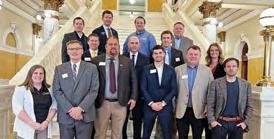

The South Dakota Soybean Checkoff partnered with NewsCenter1 to host an educational booth at the BHSS. Visitors who stopped by tried their hand at (virtual) farming, learned about soybean products, viewed episodes of Homegrown, signed up for a giveaway, and spun a wheel for a prize!
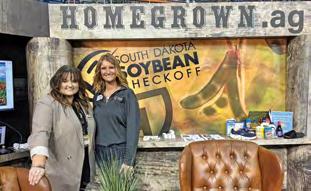
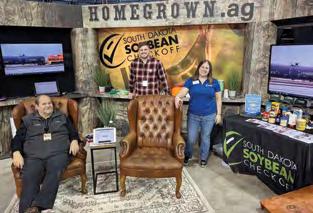
SD Soybean staff Valerie Willson visited with farmers and pork producers at the 55th Annual Pork Congress on January 10-11 in Sioux Falls. Join SD Soybean at your local shop talk to learn and hear updates from the congressional delegation, Farm Credit Services of America, Legacy Law Firm, USDA FSA, and your local soybean board directors. The program begins in the morning and concludes with a free lunch. Register online at www.sdsoybean.org for more details. We hope to see you soon!
6 Spring Issue 2024 SDSL INVESTING CHECKOFF DOLLARS
Madison area on 3/27/24 Yankton area on 4/9/24
Pork and Beans! Upcoming Producer Shop Talks: Save the Date!
AgOutlook
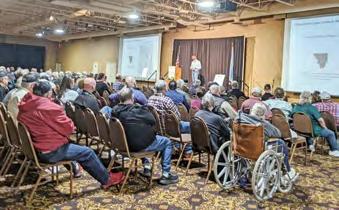

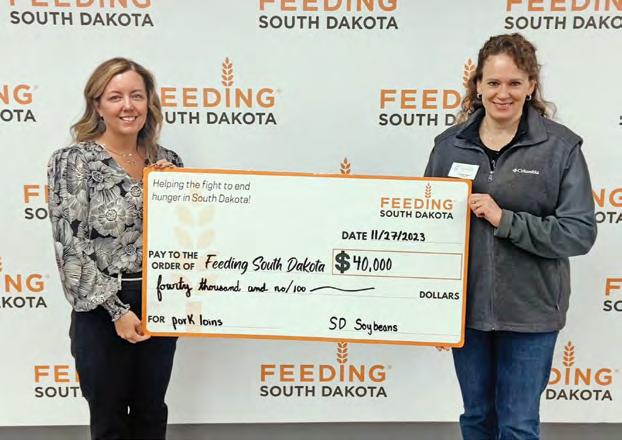
Feeding South Dakota
$40,000 dollars was used to purchase pork for Feeding South Dakota through the South Dakota soybean checkoff. This incredible contribution has gone to the purchase of pork, which has been distributed through Feeding South Dakota’s agency partners. South Dakota soybean farmers are proud to take responsibility for addressing hunger in our communities!
Spring Issue 2024 SDSL 7
SD Soybean Association hosted over 500 farmers at the 19th Annual AgOutlook Conference and Tradeshow.
Beresford FFA
( YOU )

You’re where the rubber meets the road. And the engine. And the interior.
All soybean farmers, including you, are busy replacing petroleum with your soy oil. How? By pooling your resources through your soy checkoff. Learn how your soy checkoff is bringing tangible returns back to you and your operation at unitedsoybean.org/hopper.
Moving Soy Forward.
Moving You Forward.
©2022 United Soybean Board [61977-24 9/22]

LETTER FROM THE EXECUTIVE DIRECTOR
By Jerry Schmitz,

The South Dakota Soybean Research and Promotion (Soybean Checkoff) Council is beginning its budgeting process for fiscal year 2025 which begins July 1. Their first step is reaching out to researchers for pre-proposals. Preproposals offer the Council members a birds-eye view into the world of research possibilities. Council members evaluate each pre-proposal and give a collective thumbs-up or thumbs-down. Pre-proposals are often sent to regional research groups for evaluation and comparison with related projects, or interests from other states, to see if similar research has already been completed, or if there could be a collective effort to share costs.
Pre-proposals receiving a thumbs-up are a sign of the type of projects Council members consider most impactful for South Dakota soybean farmers in the near term. The Council then requests researchers develop a full proposal for each project outlining the objectives, tactics, timeline, and budget for their proposal. Research proposals include soil health, fertility, diseases, insects, innovative technology, feed trials, and new uses just to name a few.
In April, the Council will set aside two days to review twentyplus research proposals along with proposals from organizations, agencies, and individuals that are helping to utilize and promote soybeans and agriculture in general. The United States Soybean Export Council (USSEC), Clean Fuels Alliance of America (CFAA), United States Meat Export Federation (USMEF), USA Poultry & Egg Export Council (USAPEEC), Soy Aquaculture Alliance (SAA), US Soybean Research Collaborative, Soy Transportation Coalition (STC), and many others. The goal is to increase demand domestically and across the world by directly reaching out to buyers of soybeans, and indirectly by promoting the sale of livestock, poultry, fish and industrial products that consume soybeans.
Before the April meetings, each Council member reviews over ninety proposals using a scorecard to evaluate each project, granting points on criteria including “the potential to positively impact SD soybean farmers”, “advances knowledge, practices or technology”, “the potential to leverage additional funding from other sources”, “ the potential to positively impact the ag industry”, and others. After everyone has completed the scorecard, results are combined to show the “average rating” for each project.
When the Council meets, they will discuss each project and the collective score it achieved. Information and expertise shared during the discussion often leads to individuals changing how they rated certain criteria. Occasionally a robust (nice word for hot) discussion will take place as members express their belief in the value vs lack thereof, a project holds for local farm families.
While these meetings are very professional, they can also get very emotional. Council members often express the need for judiciously spending checkoff dollars and doing their best to leverage funds to the greatest benefit of their neighbors and all soybean farmers.

Before making any final budget decisions for expenditures, the Council will look at USDA estimates for 2024 soybean acres, consider past average production and prices, and estimate potential revenue based on projected acres, yield, and price. Only then do they approve the projects that will be funded and how much they will spend on operations.
This process has resulted in increased demand for feed, food, fiber, fuel, and industrial products such as soy-based, environmentally friendly road and roof preservatives, shoes, insulation, plastics, building materials, adhesives, auto tires and seat foam, and a new fire fighting foam that is safe for humans and animals.
A special shout-out to David Struck- Chairman, Dave IversonVice-Chairman, Heather Beaner- Secretary, Todd Hanten- Treasurer, Dawn Scheier, Mike McCranie, John Horter, Bruce Haines, and Derrick Scott for the time they offer, and work they do to increase the value of soybeans for South Dakota farm families.
Spring Issue 2024 SDSL 9
JERRY SCHMITZ
Executive Director of SDSRPC and SDSA
INVESTING CHECKOFF DOLLARS
Executive Director of South Dakota Soybean Research and Promotion Council & South Dakota Soybean Association

MANY FACTORS HAVE AN IMPACT ON SOYBEAN YIELDS
There is a lot that goes into getting the best soybean yields.
Dr. Cheryl Reese at South Dakota State University lectures students and farmers on the subject and says it begins with precision farming, scouting soybean fields and working closely with suppliers.
“If I have a white mold problem, the first thing I’m going to do is talk to my seed dealer about varieties that are more resistant to white mold,” said Reese. “Soybean cyst nematode (SCN) is the same deal. If I’m planting early in the springtime, I want soybeans that have a tough root system so I may be looking at phytophthora-resistant genes.”
Dr. Reese teaches crop production courses for soybeans, corn and wheat and is a specialist in soils and fertility.
Dr. Reese analyzed data from the 2023 South Dakota Soybean Yield Contest and spoke at the AgOutlook Conference in December about agronomic practices that result in higher yields. In an interview for The Soybean POD podcast, Reese explained that it's a good idea to keep historical records of specific fields so genetics can be tailored to those fields. Specifically addressing her area of expertise in fertility, Dr. Reese talked about assessing late season nitrogen requirements
of Upper Great Plains soybeans.
“A lot of yield can be developed yet in August, because we’re filling those pods, so [the producer] asks the question of ‘70 bushels; do I have enough nitrogen in the soil?’ Well, in the studies that a lot of land grant universities have done in the north central states, we’ve seen sporadic, occasional yield improvement with an in-season N. The research we’ve done within our research group, we have not ever seen a yield increase with a late season N application.”
When should a grower plant? It’s often said that earlier planted soybeans take advantage of greater sunlight and perform better. Dr. Cheryl Reese gives this caveat.

“It’s all dependent upon weather. If I’m going to plant soybeans and I want to push my yield, I’m going to plant early, I’m going to plant a higher relative maturity. Longer relative maturities have more time for biomass, to collect sunlight, set nodes, produce pods, produce yield. But if when I planted that field early, it so
happens to coincide with a precipitation event that starts the growth of white mold in my field, then maybe my later planted field may have a higher yield if I cannot control that white mold. So there’s many factors involved with yield in soybeans,” said Reese. “And the one thing we can’t control is the weather.”
10 Spring Issue 2024 SDSL
Hear more from Dr. Cheryl Reese on The Soybean POD wherever you get your podcasts. INVESTING CHECKOFF DOLLARS
CHERYL REESE

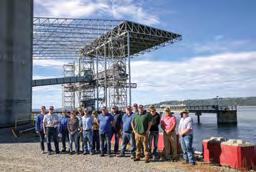





Spring Issue 2024 SDSL 11 w w w . sdso y bea n. o r g ( 6 05 ) -3 3 0-9 9 4 2
D
are i n v i ted to learn h o w so y
exp o rted o n a so y b ean ch ecko ff-sp o n
r Y
to ur July 8 - 1 1 i n th e P aci fi c N o rth west. A P P L Y B Y M A Y 1 2, 2024 P hot os f r om 2023 See For Y our sel f t our
So uth
ako ta farmers
b ean s are
so red See Fo
o urself
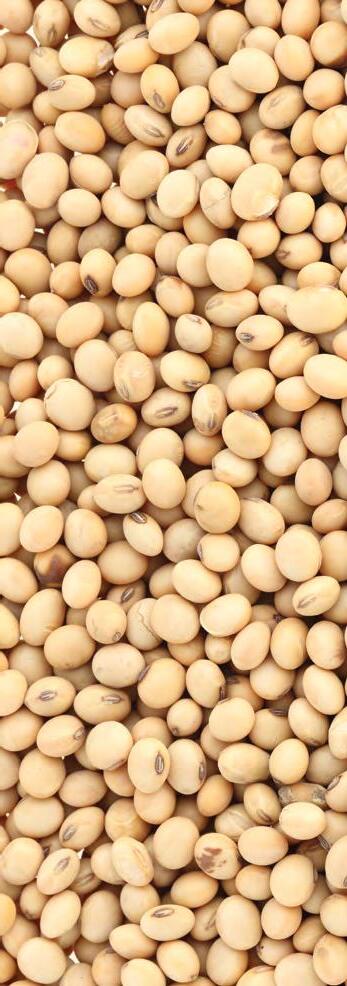
SOYBEAN USES YOU MAY HAVE NEVER HEARD OF 5
South Dakota soybean farmers have long invested in new use research and promotion efforts through their checkoff, and the results have been outstanding to date. New uses for soybean oil and soybean meal have emerged right here in South Dakota just in the past few years, adding increased market versatility and supporting overall soybean demand:
Checkoff dollars helped promote soy-based tires by equipping law enforcement vehicles across the state with tires made by Goodyear.
South Dakota State University and Dakota State University have upgraded their athletic fields over the past decade to utilize soy-based turf products.
Another checkoff-supported initiative has brought a new soy-based sealant to the streets of Sioux Falls as well as a pilot program in Badlands National Park.
These recent accomplishments notwithstanding, it could also be argued that we’ve just scratched the surface in terms of soy-based possibilities. That’s a primary reason the South Dakota Soybean Research and Promotion Council has advocated for and contributed funds toward the POET Bioproducts Center in Brookings, home to Dakota BioWorx and a growing number of exciting new enterprises exploring soy uses and other bio-based products.


12 Spring Issue 2024 SDSL
INVESTING CHECKOFF DOLLARS
underlayments
has
developing environmentally
years.
Foam Products Corporation (FPC), one of the world’s largest producers of acoustical
for the flooring industry,
been
friendly, sustainable, “green” products for
LESSER-KNOWN SOY USES
In addition to some of the high-profile soy-based products mentioned above, here are some lesser-known uses stemming from extensive soybean research and innovation.
COSMETIC PRODUCTS
The growing green cosmetics movement has accelerated the use of soy derivatives in skin products such as face cleansers, sunscreen, and eye makeup. These soy-based products offer consumers concerned about toxins and the environmental impact of traditional skincare products a more natural, sustainable alternative.
LUBRICANTS


Much attention has been paid to soybean oil’s pivotal role within the renewable fuels movement over the past several years, and for good reason. You’ve likely heard less about soy-based motor oil, a green alternative now in use within the auto industry that reduces our collective dependence on petroleum-based lubricants.
BIODEGRADABLE MULCH FILM
Petroleum typically serves as the principal component in polyethylene plastic mulch films used extensively in specialty agriculture, home gardens, parks and playgrounds. However, a new biodegradable mulch film that uses renewable polymers derived from soybeans now exists thanks to bio-based polymer research, providing a more sustainable alternative that can be tilled into the soil after use.
ACOUSTICAL UNDERLAYMENTS
What is an acoustical underlayment? We’re glad you asked. Acoustical underlayments are laid before flooring is installed in the construction process to assist with noise reduction. They are traditionally produced using petroleum-based chemicals, but a green, soy-based acoustical underlayment has arrived on the market as an alternative option and promises to entice builders and contractors seeking Leadership in Energy and Environmental Design (L.E.E.D.) certification.
CABINETRY PLYWOOD
Manufacturers of decorative plywood used in cabinets and shelving units have harnessed adhesive properties inherent in renewable, nontoxic soybean meal to replace formaldehyde, which the Centers for Disease Control and Prevention has identified as a toxic substance. This breakthrough use has the potential to meet increasing demand for eco-friendly solutions for new construction and home renovation.
LEARN MORE ABOUT NEW USES FOR SOY
New uses for soybeans continue to emerge on a regular basis. To stay up to date on the latest developments and soy-based innovation, talk with your South Dakota Soybean Research and Promotion Council district director or visit the soy uses page on our website.



Spring Issue 2024 SDSL 13
Custom built planters for Agtegra farmers. Every ARx Planter is unique to each farmer and their operation. Starting with the bare planter bar, Agtegra Innovation Center specialists work with you to custom design and build your planter. Every component decision is yours to make! We partner with brands like Harvest International®, Precision Planting® and Yetter® and even manufacture components in-house. Planters are then assembled right here in Agtegra territory at your local Innovation Center. Contact an Innovation Center local to you to design your ARx Planter! Bath, SD (605) 725-1890 Huron, SD (605) 846-1212 Bowdle, SD (605) 846-1047

SOY MEETS WORLD: HOW CHECKOFF INITIATIVES PREPARE OUR SOYBEAN INDUSTRY FOR THE FUTURE
Farmers know as well as anyone that the actions we take now profoundly impact what will happen in the future. Enter the South Dakota Soybean Research and Promotion Council, which works to ensure today’s younger growers have access to the resources and opportunities they need to secure a brighter future and, in turn, establish a legacy they can pass down to the next generation of farmers.
Let’s take a closer look at some of the key ways South Dakota farmers are investing in the future of the soybean industry — and the up-and-coming leaders who will bring it to fruition — through their checkoff.
LEADERSHIP DEVELOPMENT THROUGH SOUTH DAKOTA SOYBEAN
The South Dakota Soybean Genesis Leaders Program, now in its third year, is a shining example of the checkoff’s focus on developing our next generation of industry leaders and advocates. Designed in partnership with the South Dakota Ag and Rural Leadership (SDARL) program, Genesis Leaders focuses on emerging leaders within the industry. It puts a cohort model to work to engage participants ages 21 and up in hands-on learning about industry infrastructure, policy, innovation, leadership development and more.
"We needed to figure out what people in the soybean industry would really want to learn more about," explained SDARL Program Director Jennifer Henrie. "So we came up with this series of four seminars that incorporated industry education and leadership development."
Henrie helped launch the Genesis Leaders initiative in 2021 and continues to guide it today. She noted that each cohort has included a mix of growers and leaders in other areas of the soybean industry. Some have prior experience serving as board members, while others are just beginning to explore leadership opportunities. "Organizations in the ag industry are looking for people to step up," she said. "Genesis Leaders gives them a taste of what they can learn elsewhere if they wanted to pursue additional leadership training, but it's not an overwhelming prospect from the get-go."
To that end, the farmer-led boards of South Dakota Soybean Research and Promotion Council and South Dakota Soybean Association have served as fertile ground for leadership development for younger producers.
John Horter is one such individual. The row crop farmer from Andover, SD, previously served on the South Dakota Soybean Association Board of Directors and is now District 8 Director for the South Dakota Soybean Research and Promotion Council.
"I wouldn't consider myself to be a very outspoken leader, but I've had the opportunity to participate in leadership development trainings that have brought that out in me," said Horter. "It has been a great experience."
He believes that opportunities for a younger generation of producers to get involved in leadership roles are key to the industry's future. "It's very important to get new people involved and hear their perspectives," said Horter. "A lot of people have a lot of ideas, but they don't always bring them forward or push them to where they need to be."
14 Spring Issue 2024 SDSL INVESTING CHECKOFF DOLLARS
BECOMING AMBASSADORS FOR THE SOYBEAN INDUSTRY
Sustaining global demand and strong, healthy export markets are crucial to soybean value, both today and far into the future. With increased competition from Brazil and Argentina, our farmers need to play an active role in building relationships around the world and promoting the advantages of soybeans grown here in the U.S.
Thankfully, younger producers have played a big role in representing the soybean industry through trade tours, both as hosts to international buyers who visit South Dakota and as delegates traveling to emerging markets in other countries.
Likewise, the Hungry for Truth initiative has played a key role in providing educational opportunities and building trust with consumers. Younger producers have contributed in many significant ways to Hungry for Truth's success by hosting farm visits with social media influencers and attending the annual Farm-to-Fork event.
"There's a huge disconnect between agriculture and today's consumers," said Horter."They don't always understand what we're doing as farmers and they might get their information sources from someone that isn't necessarily reliable."
"We just want to be available to tell people what we do," explained Horter, "and that the way we're farming really does have their best interests in mind, too. Hungry for Truth is an opportunity to connect and allow people to ask questions about what we do."
Producers also have the opportunity through See For Yourself tours to visit U.S. ports where soybeans are shipped to overseas markets to better understand the logistical needs and checkoff investments in infrastructure to support soybean exports.
LEVELING UP SOYBEAN PRODUCTION PRACTICES
For long-term profitability, soybean farmers must continuously fine-tune production practices in order to boost yields and increase the efficiency of their operations. That’s why the Soybean Yield and Quality Contest is vital to advancing soybean yield outcomes in South Dakota.
Jointly sponsored by South Dakota Soybean Research and Promotion Council and South Dakota Soybean Processors, the annual contest allows growers to utilize different agronomic practices to get more out of every acre. Once yield results and field data are compiled, South Dakota State University Extension agronomists and field specialists analyze this information to provide insights to other soybean producers during the annual checkoffsponsored Soy 100 event.
"Soy 100 is a great opportunity to share ideas, network and learn," said Horter. "The cost of production is way higher than it was 20 years ago, so how do we produce more to offset those costs?"
Farmers also fund a wide swath of agronomic research trials through their checkoff in partnership with SDSU Extension to address soil management, pest pressure, seed selection, planting practices and more, helping to inform on-farm decisions.
STAY CONNECTED WITH YOUR CHECKOFF
These are just a few of the many ways soybean producers in South Dakota are securing a brighter future through their checkoff. To learn about other opportunities to grow both on and off the farm, please visit sdsoybean.org or talk to your local district director.



Spring Issue 2024 SDSL 15
Prairie AquaTech
Dr. Bob Thaler
Dakota BioWorx tour

FOURTH GENERATION FARMER SHARES FARMING WITH YOUTUBE AUDIENCE
Cole Sonne, a fourth-generation farmer from Mt. Vernon is well known for his large following on YouTube today. Cole Sonne’s accidental fall into content creation has transformed him into a vocal advocate for farmers. Growing up on his family farm in Mount Vernon, South Dakota, Cole knew a life in agriculture was the life for him.
During COVID-19, he came home from college with increased knowledge of agronomy and animal husbandry. He was ready more than ever to take over his family farm.
Cole flew around his family farm, capturing video with a drone. He was unsure where to upload the various drone clips so he decided to share his videos on YouTube. He had no idea that they would be a hit with a large audience. The Sonne Farms YouTube channel began and has continued to grow.
He offers a glimpse into farm life, entertaining viewers while providing valuable insights into farming practices. Cole emphasizes the importance of sharing genuine knowledge on social media platforms, countering the prevalent misinformation.
As a young farmer, Cole sheds light on the challenges faced. He highlights the crucial role of the organization Farm Rescue in assisting during critical seasons of illness or injury. Cole uses his voice to open conversations on mental health within the farming community. Cole advocates for breaking the stoic stereotype and creating a support system.
Cole Sonne's journey from accidental content creator to a voice for farmers reflects the changing of times. Cole embodies the characteristics of resilience, passion, and a commitment to sustainability. His story serves as an inspiration for the next generation of farmers. Encouraging new farmers to embrace change and cultivate a prosperous future for American agriculture.


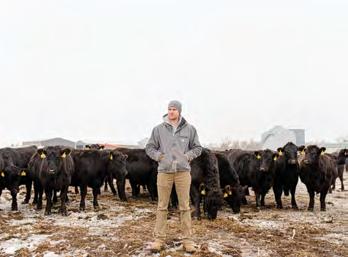

16 Spring Issue 2024 SDSL INVESTING CHECKOFF DOLLARS

MINI HAM AND CHEESE EGG BAKES
Prep Time: 8 Min | Total Time: 8 Min

INGREDIENTS
8 eggs
1/2 cup Soy Milk
1 tsp Salt
1 tsp Pepper
1/4 cup green onions sliced
1/2 cup cheddar cheese freshly grated
5 oz ham diced
INSTRUCTIONS
1. Preheat the oven to 375° F.
2. Spray a 12-cup muffin tin with non-stick spray.
3. Beat eggs, soy milk, salt, pepper and green onions in a medium mixing bowl until smooth.
4. Fill each muffin cup with an evenly distributed amount of ham and cheese.
5. Pour egg mixture on top of ham and cheese, dividing evenly.
6. Bake for about 8-10 minutes.
7. Using a rubber spatula, loosen the egg bakes from the muffin tin and plate. Serve immediately.

Check out our latest ambassador pairing where we had an exciting opportunity to connect farm-raised Business Development Banker at Dacotah Bank, Jesse Carlson, with David Struck, a fifth-generation farmer from Wolsey, S.D., to chat about farming, land, family, and much more.

Ambassador Program
Connecting and giving real people access to a real South Dakota farm to learn, observe, ask questions, engage with farmers, and see first-hand how South Dakota farming operations go round.
Read all our Ambassador Pairing stories online at hungryfortruthsd.com/ ambassador-program
Or scan QR code
Spring Issue 2024 SDSL 17 Find more recipes at hungryfortruthsd.com
David Struck and Jesse Carlson
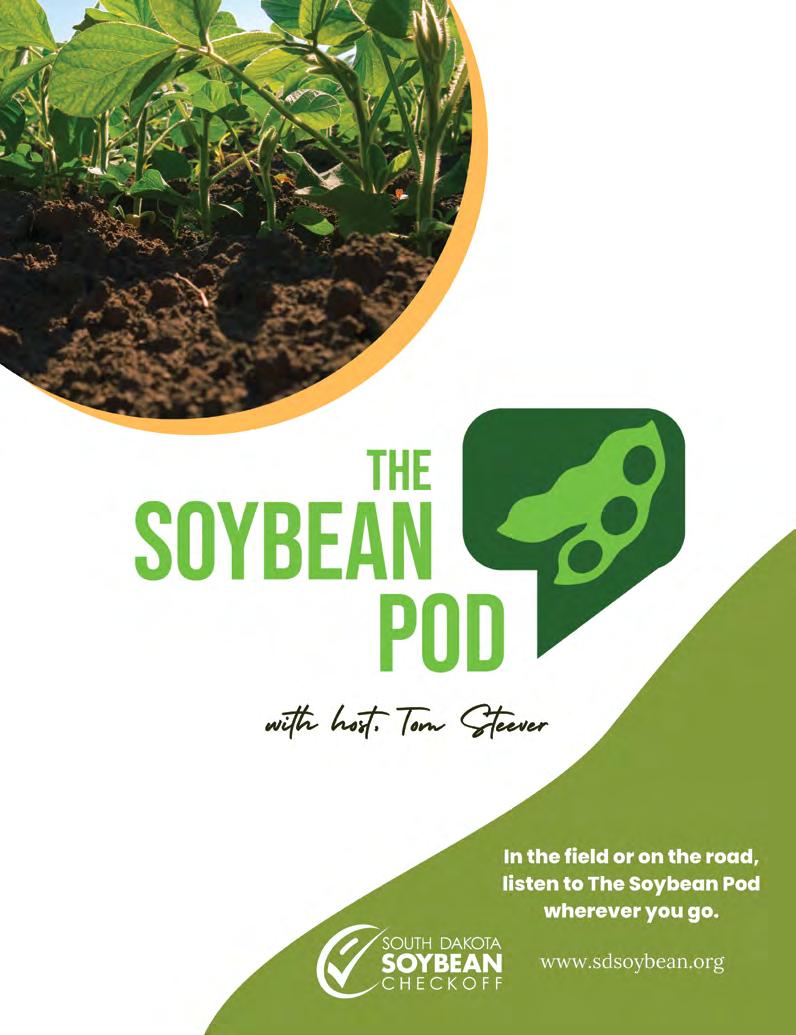

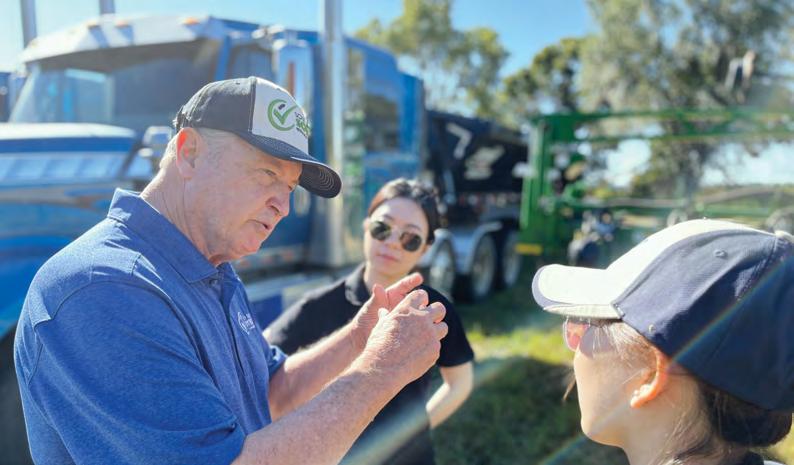
FULL CIRCLE: SOUTH DAKOTA SOYBEAN FARMERS SEE LONG-TERM INVESTMENTS PAY OFF
On Monday, August 21, 2023 in a nondescript hotel meeting room in New York City, Mike McCranie watched one of the largest ingredient importers in Thailand sign a Memorandum of Understanding with the U.S. Soybean Export Council (USSEC) for support sourcing sustainable soybeans and soybean meal for food and animal feed ingredients.
In that moment, he saw much more than just a formal agreement leading to the purchase of U.S. Soy products. He saw proof of the payoff for deep industry collaboration, long-term soy checkoff investments and generations of ag industry service.
McCranie farms near Claremont, South Dakota, with his wife Monica and their sons Matthew and Mitchell. As a board member for the South Dakota Soybean Research and Promotion Council, he also serves as a director for Northern Soy Marketing, the United Soybean Board and USSEC.
“During a meeting organized by USSEC in Thailand, I heard the leadership of a major ingredients company request help sourcing sustainable soybeans, which led to the signing event during Soy Connext in New York City,” he explained. “The path to that point required lots of work and forward thinking over many years, and it was exciting to see an example of how that came together.”
The request from Bangkok Produce Merchandising (BKP), the purchasing arm of Charoen Pokphand Foods PCL, or CP Foods, came out of the combination of reliable sourcing, building genuine business relationships and proving sustainability.
Through his years of industry service — and even his family history — McCranie played a variety of small roles that contributed to making that agreement possible. He says this is just one result of many organizations working together, a variety of strategic
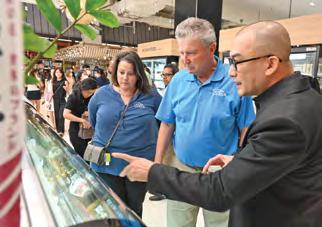
investments and commitment from farmers like him to continue improving how they raise soybeans.
BECOMING A RELIABLE SOURCE OF SOYBEANS
McCranie first served on the South Dakota Soybean Research and Promotion Council in the mid-1990s, when the organization had funded a feasibility study for a soybean crushing plant in South Dakota. That study and other efforts contributed to the eventual creation of South Dakota Soybean Processors.
After a hiatus while his sons were growing up, he returned to the board in 2016, when a similar checkoff-funded feasibility study showed that with the growth in soybean acres in South Dakota,
20 Spring Issue 2024 SDSL INVESTING CHECKOFF DOLLARS
Mike McCranie learns more about consumer needs and priorities during his 2023 visit to Thailand.
Mike McCranie answered questions about soybean production from BKP soybean meal and DDGs buyers while they visited his farm.
the state could support another crushing plant. McCranie participated in a local working group to showcase the potential for another crushing plant in his area of the state, specifically Aberdeen, and Ag Processing, Inc., commonly known as AGP, notes that these efforts contributed to the company’s decision to open a crushing facility there in July 2019.
“The South Dakota Soybean Research and Promotion Council collaborated with other soybean checkoff organizations, including the United Soybean Board, to support and encourage other industry developments that solidify this region as a reliable source of soybeans,” McCranie said. “It took everybody working together to make that happen. A quote I like to repeat is, ‘Collaboration is the new currency.’ ”
The studies and information from those collaborations contributed to groundwork for infrastructure development of the rail and port system from the Northern Plains to the Pacific Northwest that gets South Dakota soybeans to global customers. For example, South Dakota Soybean Processors now operates two crushing plants, with plans to open a third in Mitchell in 2025. And, AGP acted on that information by expanding their soybean meal handling capabilities at the Port of Grays Harbor in Washington state.
“Today, we export about seven out of every 10 rows of soybeans we grow in South Dakota,” McCranie said.
BUILDING CUSTOMER RELATIONSHIPS
At the same time, McCranie participated in building relationships with potential customers for those soybeans in Southeast Asia. Through his appointment to Northern Soy Marketing, he participated in a trade mission to Thailand in December 2016.
“We stressed the quality of our soybeans, because work focused on amino acid digestibility was just getting underway,” he remembered. “However, the potential customers in Thailand were very price-focused, making it a challenge for U.S. Soy to compete.”
Soy checkoff organizations continued investing in Thailand and in the export industry in the U.S. In August 2022, AGP hosted a small group from Bangkok Produce Merchandising, or BKP. Part of their planned tour included the soy crushing plant in Aberdeen.
“AGP contacted South Dakota Soybean Research and Promotion Council to ask if a farmer in the area would host the group on their farm, and my family jumped at the chance to welcome them,” McCranie said. “The group included their soybean meal and DDGs buyers, as well as a couple of their internal soybean crop experts.
TIMELINE
1881
Mike McCranie’s great-grandfather, Louis Johnson, homesteads in Brown County, South Dakota. The McCranies purchased this land and farm it today.
1942
Monica McCranie’s grandfather, Frank Feser, becomes one of the first farmer board members of the South Dakota Association of Conservation Districts. He served as organization president from 1947 to 1955, leading a major sustainability effort for South Dakota farmers. The McCranies also purchased his land and farm it, as well.
1950s AND 1960s
Mike was born and grew up on his parents’ farm near Shephard, Montana. Monica was born in Culbertson, Montana, and grew up in the Pacific Northwest.
1971
Mike begins renting a quarter of his grandfather’s land near Claremont, South Dakota, as a summer job.
1976
Mike moves to South Dakota as his summer job evolves into his full-time career.
1980s AND 1990s
Mike and Monica married and expanded their operation over time, raising sons Matthew and Mitchell on the farm.
1994
Mike begins his first term with South Dakota Soybean Research and Promotion Council, when a feasibility study showed the potential of a crushing plant in the state.
2016
Mike visits Thailand for the first time to meet with potential customers, whose primary interest was price.




2019
AGP opens a soy crushing facility in Aberdeen, based in part on a feasibility study funded by the South Dakota Research and Promotion Council and local collaborative efforts Mike chaired.
2022
The McCranies welcomed the BKP group hosted by AGP to their farm.
JULY 2023
Mike reconnects with BKP team members that visited his farm during a USSEC meeting in Bangkok, Thailand.
AUGUST 2023
Mike with BKP leadership at the Memorandum of Understanding signing during Soy Connext in New York City.
Spring Issue 2024 SDSL 21
“We showed them our soybean fields, gave combine rides and treated them to a steak lunch in nearby Amherst,” he recalled.
In July 2023, McCranie participated in a USSEC trip to Thailand, which included meetings with key businesses.
“CP Foods hosted our group to meet with BKP representatives,” he said. “As their team members filed into the meeting, I saw the two ladies who buy soybean meal and DDGs that had visited our farm the year before! We enjoyed reconnecting.”
PROVEN SUSTAINABILITY
It was during that meeting that McCranie heard the request for help sourcing sustainable soybeans and soybean meal.
“Unlike my first trip to Thailand, the focus shifted to sustainability because that’s what CP Foods customers were interested in,” he explained. “For years, South Dakota and U.S. farmers have been demonstrating our commitment to sustainability and continuous improvement.”
He points to his wife Monica’s grandfather, Claremont farmer Frank Feser, who was on the initial board of the South Dakota Association of Soil Conservation Districts when it was formed in 1942. Feser served as president of the organization for several years.
“We continue building on his legacy of conservation and sustainability,” McCranie said. “We were fortunate to purchase
land he farmed, as well as the land my great-grandfather homesteaded in 1881, and we farm this ground still today. We have made vast productivity and sustainability improvements. That will continue as our sons Matthew and Mitchell continue farming. Our top goal is to pass the land on in better condition than when we started farming it.”
He explains that USSEC, U.S. Soy’s international marketing group, helps international customers document the sustainability of U.S. Soy through the U.S. Soy Sustainability Assurance Protocol, or SSAP. The SSAP verifies that soybeans and soy products produced in U.S. comply with set sustainability standards, and the certificates for documentation can be transferred along the supply chain, providing industry-wide assurance.
“The regional USSEC team in Thailand assured company leadership that we could help, as soon as the request was made,” he added. “The MOU signing in New York City was the result.”
When he looks back to his first years serving on soy checkoff boards, he realizes that progress requires the collaboration of many different groups, working toward overall, long-term goals.
“You never know the value of the relationships created through these efforts, but it is clearly so important to build them,” McCranie concluded. “It makes me incredibly proud of our checkoff organizations and what we have accomplished.”
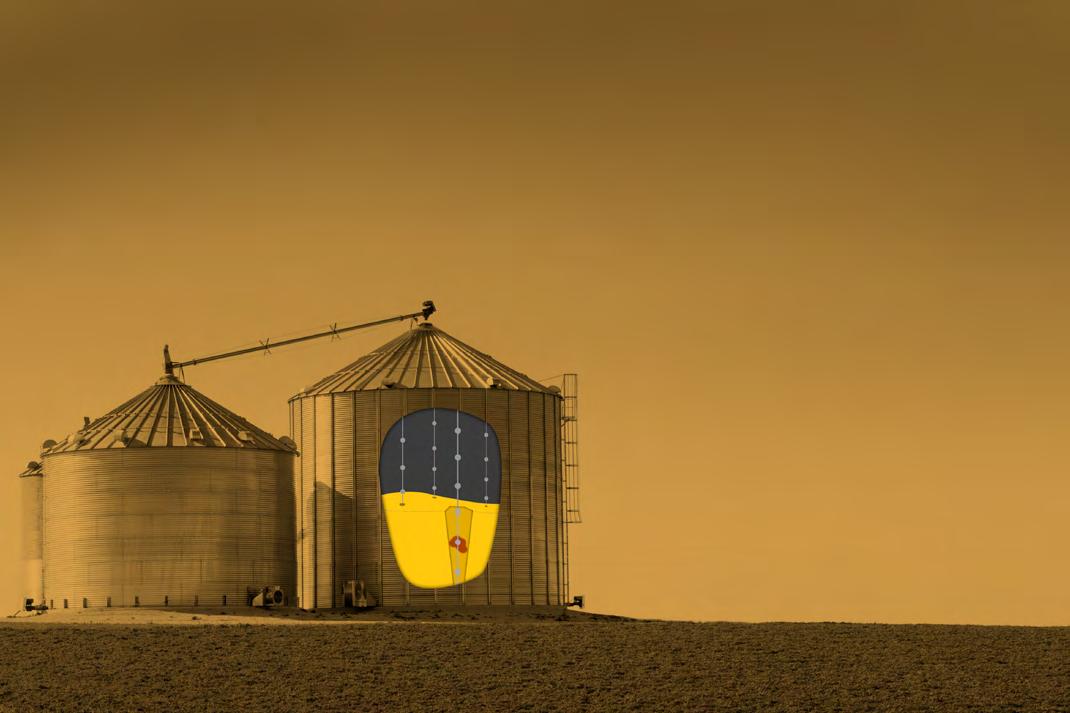


SUPPORT
Tri-States Grain Conditioning systems will help you remotely monitor your grain. With our temperature cables, you will save on energy costs and improve your overall grain storage. TSGCINC.COM 800.438.8367 ™
FREE TECH
FOR LIFE
(Continued)
Full Circle: South Dakota Soybean Farmers See Long-Term Investments Pay Off



Spring Issue 2024 SDSL

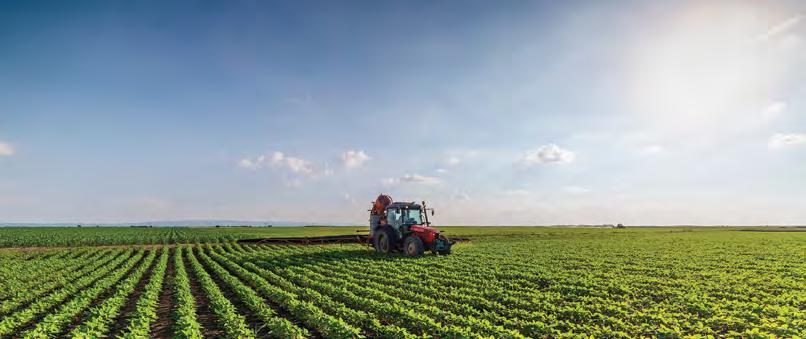
SD Soybean Checkoff Research Reports Continued




Spring Issue 2024 SDSL SD Soybean Checkoff Research Reports Continued


SD Soybean Checkoff Research Reports Continued


Spring Issue 2024 SDSL 27 SD Soybean Checkoff Research Reports Continued


Spring Issue 2024 SDSL SD Soybean Checkoff Research Reports Continued





( YOU )





You just increased your sales to Egypt 708%. Bon voyage.
All soybean farmers, including you, have been busy racking up big sales with export markets. How? By pooling your resources through your soy checkoff. Learn how your soy checkoff is bringing tangible returns back to you and your operation at unitedsoybean.org/hopper
Moving Soy Forward. Moving You Forward.

Get $50 per acre to plant cover crops – Enrollment now open!
Boost Your Bottom Line with Farmers for Soil Health


Farmers for Soil Health – a program built by farmers for farmers – was launched to enhance soil health and farmer profitability. A partnership between the National Corn Growers Association, the United Soybean Board, and the United Pork Board, it supports farmers by providing financial incentives and dedicated technical advisors to help in the successful adoption of cover crops

W h y F a r m e r s f o r S o i l H e a l t h ?
F i n a n c i a l I n c e n t i v e
W i t h F a r m e r s f o r S o i l H e a l t h , i t ’ s n o t a b o u t c o s t s ; i t ’ s
a b o u t i n v e s t m e n t W e o f f e r f i n a n c i a l a s s i s t a n c e o f u p t o
$ 5 0 / a c r e o v e r a t h r e e - y e a r p e r i o d t o h e l p c o v e r t h e
t r a n s i t i o n s t a r t - u p c o s t s .
T e c h n i c a l A d v i s o r s


S o u t h D a k o t a h a s a d e d i c a t e d o n - t h e - g r o u n d t e c h n i c a l a d v i s o r a n d e x p e r i e n c e d f a r m e r s s e r v i n g a s c o v e r c r o p c o a c h e s t o p r o v i d e r e s e a r c h - b a s e d i n f o r m a t i o n a n d e d u c a t i o n a l r e s o u r c e s t o a i d i n t he t r a n s i t i o n o f y o u r f i e l d s a t n o c o s t t o p r o g r a m p a r t i c i p a n t s I f y o u h a v e a n y q u e s t i o n s a t a l l , t h e y c a n p r o v i d e g u i d a n c e o n s o i l , c l i m a t e , c r o p s p e c i e s s e c t i o n a n d m o r e . E a s y E n r o l l m e n t T h e F a r m e r s f o r S o i l H e a l t h p r o g r a m a l l o w s f o r s i m p l e s e l f - e n r o l l m e n t a n d o f f e r s s t r a i g h t f o r w a r d a n d s w i f t p r o c e s s e s T h e r e i s n o a c r e a g e m i n i m u m o r i n c o m e c a p s , a n d f a r m e r s c a n e n r o l l u p t o 1 , 0 0 0 a c r e s p e r f a r m e n t i t y W i t h F a r m e r s f o r S o i l H e a l t h , y o u ’ r e t a p p i n g i n t o p r o v e n m e t h o d s t h at o f f e r t a n g i b l e b e n e f i t s . I t ’ s a c l e a r p a t h w i t h :
- B e t t e r s o i l h e a l t h ;
- F i n a n c i a l i




 - Jerry Schmitz, Executive Director, South Dakota Soybean Association
- Jerry Schmitz, Executive Director, South Dakota Soybean Association
















Spring Issue 2024
n c e n t i v e s ; a n d - E x p e r t a d v i c e w h e n y o u n e e d i t . Learn more about Farmers for Soil Health by visiting FarmersForSoilHealth com Or contact your South Dakota technical advisor, Julia Gerlach, at gerlach@ctic.org or 414-394-9973. This material is based upon work supported by the U S Department of Agriculture, under agreement number NR233A750004G003 Any opinions findings conclusions or recommendations expressed in this publication are those of the author(s) and do not necessarily reflect the views of the U S Department of Agriculture In addition, any reference to specific grants or types of products or services does not constitute or imply an endorsement by the U S Department of Agriculture for those products or services “Enhancing farms by incorporating economically and ecologically beneficial soil practices such as cover crops
many benefits in the short term
success of future generations of farm families.”
provides
while contributing to the





SOUTH DAKOTA SOYBEAN STORIES: TANNER HENTO

Tanner Hento is an advocate for mental health among his fellow farmers. Hento, secretary of the South Dakota Soybean Association from Avon, lost his mother to suicide when he was 22. Although certainly not a pleasant subject to bring up, according to Hento, talking about one’s response to stress is important.
“I’m just kind of trying to be more overt about it and talking about things when we do have a problem, and I’ve kind of carried that with me with agriculture,” Hento told the South Dakota Soybean Network. “I’m well aware of the stresses and it’s somewhat mitigated now that prices have been better, but times are going to get tough again, and I think farmers try to be very stoic and act like everything is ok. I try to push that it’s ok to say we need help. Your mental health is no different to me than if you have a heart problem.”
There will always be circumstances resulting in stress, and while farmers are not the most likely to discuss feelings, in Hento’s opinion, sharing one’s burdens is essential.
“It’s ok to not be ok and talk about when you do have a problem, especially to family, before something gets worse,” he said. “Being a really big proponent of openness is really what I’m going for.”
Hento said the loss of his mother was not connected to agriculture, but he adds that reaching out to caring individuals,
either professionals or loved ones, might prevent something that leaves survivors with deep scars.
“Even if you don’t want to divulge too much, just admitting that things aren’t ok goes a long way,” said Hento. “A lot of people just want to be heard even if there isn’t a solution, just knowing that there’s somebody there for you when you are ready. I think, especially for my own mother, the loneliness and feeling of alone is what got her, so I think if we can just learn to somewhat lean on each other. Even if it’s something as simple as saying ‘I’m not ok,’ I think would be a great way to start.”
Hento had his own stress to cope with. He lost both parents within six months of each other. He remains comfortable with his decision a decade ago to leave med school and return, with his brother, to run the family farm.
“I really felt at peace with the farm. I knew that it was my calling. I knew that there was something greater for me to do than my career in medicine at the time,” he said. “It was really agriculture that pushed me through. It was a love of the fam, feeling that even though my parents were gone in this mortal world, they were still with me out there in the field,” concluded Hento. “That’s how I handled that.”
Spring Issue 2024 SDSL 31
INVESTING CHECKOFF DOLLARS
SOY TRANSPORTATION COALITION CONTRIBUTION FURTHERS GREAT LAKES PORT
Mike Steenhoek believes a contribution the Soy Transportation Coalition (STC) made toward work being done at Port Milwaukee will pay off for Upper Midwest soybean growers, including those in South Dakota. Steenhoek, the coalition’s executive director, says the $200,000 contribution will help underwrite several facets of the project's second phase. The money is a show of support by soybean farmers to the Great Lakes/St. Lawrence Seaway, according to Steenhoek, who calls that shipping lane “modest in comparison to places like the Mississippi Gulf, the Pacific Northwest and some of our other key export regions,” he said. “We do believe that it can and should be a more viable option for U.S. agriculture all in this effort to try to diversify our supply chain.”
The investment from the Soy Transportation Coalition augments a nearly $9.3 million Port Infrastructure Grant from the U.S. Maritime Administration to the DeLong Company’s Agriculture Maritime Export Facility’s Phase II project at the port.
“It’s just a good example of soybean farmers really finding opportunities to make tangible investments in the supply chain to better position our industry for success,” Steenhoek said. “We’ve had a number of examples of this, and farmers really respond to it. They like seeing something tangible happen with their checkoff dollars.”
Phase I of the facility was opened in July of 2023, and primarily has been used to export distillers dried grains to international markets via the Great Lakes/St. Lawrence Seaway, according to a news release from the STC. Phase II of the project will involve the construction of two grain storage silos, electrical service upgrades, and additional handling equipment, the release continued. Once Phase II is completed, DeLong estimates they will be exporting 120,000 additional metric tons of soybeans from the facility. Soybean meal exports are also a potential area of growth in the future.
In its news release, the STC cited three areas of motivation to provide funding for this project: It provides meaningful investment to a project that will enhance U.S. soybean and soy product exports in the near future. It’s an opportunity to invest in the Great Lakes/St. Lawrence Seaway, a supply chain option that can be a more significant conduit to the global marketplace. Finally, it’s an opportunity for the DeLong Company and Port Milwaukee to be able to highlight the funding commitment from a farmer organization, which enhances the viability and competitiveness of the organizations’ grant application.
Attention is necessarily being paid to every possible export path for U.S.-grown soybeans. Among the reasons, according to


Steenhoek, is that greater soy-based renewable fuels production has resulted in greater supplies of soybean meal not only for domestic use but also to satisfy export demand. Most, but not all of that exported soybean meal will exit through the Gulf of Mexico or the Pacific Northwest.
“We think some of that will also go to the Great Lakes system and I think there are going to be a number of states. That will be a pleasant surprise how many states actually feed into it, and it could be the states of North and South Dakota,” said Steenhoek. “Obviously, that remains to be seen but it’s an interesting prospect.”
32 Spring Issue 2024 SDSL
INVESTING CHECKOFF DOLLARS
Barge Flotilla Lock and Dam
Bulk Vessel IV - Port of Vancouver

Spring Issue 2024 SDSL 33 WE’RE READY TO HELP We’ve been trusted by South Dakota’s farmers and ranchers for more than 135 years, and we’re not stopping now. • Equipment, operating, and installment loans • Ag checking and savings accounts • Crop and livestock insurance • Producer education Contact one of our Ag Bankers to see how they can help you make your dream a reality. READY TO GROW This agency is an Equal Opportunity Provider 5217 S. Louise Ave., Sioux Falls (605) 335-5110 fnbsf.com
Grant Olson
Phil DeGroot
Brian Gilbert
Josh Kayser



DEDICATED AND DISTINGUISHED
AWARDS TIM OSTREAM
The SD Soybean Association proudly presents the Distinguished Service Award, honoring an individual's unwavering dedication and years of service to advancing the soybean industry, embodying excellence, leadership, and innovation.
Tim and his family live and farm near Centerville. He has served several years as a Director and officer on the South Dakota Soybean Research and Promotion Council, Clean Fuels board, and United Soybean Board.
SOY ADVOCATE OF THE YEAR
ROGER CHASE
The SD Soybean Association celebrates the Soy Advocate of the Year, recognizing outstanding commitment to promoting and advancing the soybean industry through advocacy, leadership, and passion for sustainable agriculture.
Roger has served in the SD House of Representatives since 2017. As a member of the House Ag Committee, Roger has carried the torch for farmers across the state. Roger farms with his family near Huron.


VISIONARY LEADERSHIP
STEVE DICK
The Visionary Leadership Award, bestowed by the SD Soybean Research and Promotion Council, honors an individual's exceptional foresight, innovation, and years of dedicated service in advancing South Dakota agriculture. Steve was appointed by the Biden Administration to serve as the Executive Director of the USDA Farm Service Agency in South Dakota. Prior to that, he served 17 years as Executive Director for Ag United. Steve is a native of Canistota where he fed cattle and grew corn and soybeans.
34 Spring Issue 2024 SDSL 2023


















Spring Issue 2024 SDSL 35 YIELD ADVANTAGE1 3 BU/A OUR A-GAME TO M TCH. HAS THE RESULTS 1Data is based on an average of 2022 on-farm and IMPACT™ trial comparisons made in the U.S. of top 25 demand planned A-Series Enlist E3® varieties through November 20, 2022. Comparisons are against Asgrow® XtendFlex® varieties and within a +/- 3 RM of the competitive brand. Product responses are variable and subject to any number of environmental, disease and pest pressures. Individual results may vary. Multi-year and multi-location data are a better predictor of future performance. DO NOT USE THIS OR ANY OTHER DATA FROM A LIMITED NUMBER OF TRIALS AS A SIGNIFICANT FACTOR IN PRODUCT SELECTION. Refer to www. pioneer.com or contact a Pioneer sales representative or authorized dealer for the latest and complete listing of traits and scores for each Pioneer® brand product. The transgenic soybean event in Enlist E3® soybeans is jointly developed and owned by Corteva Agriscience and M.S. Technologies L.L.C. Pioneer® brand products are provided subject to the terms and conditions of purchase which are part of the labeling and purchase documents. ™ ® Trademarks of Corteva Agriscience and its affiliated companies. © 2024 Corteva. 019462 Sign up for local results.





















 DAVID STRUCK, Chairman of SDSRPC
DAVID STRUCK, Chairman of SDSRPC














































































 - Jerry Schmitz, Executive Director, South Dakota Soybean Association
- Jerry Schmitz, Executive Director, South Dakota Soybean Association














































